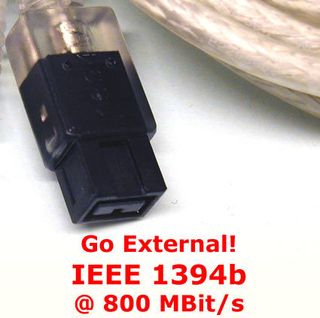Go External: FireWire 800
FireWire's High Speed Data Transfer Potential

In spite of a maximum rate of 400 Mbps for FireWire (S400) and up to 480 Mbps for USB 2.0, USB is trailing behind. Why? The performance disparity hinges on FireWire's application, which offers more robust data transfer overall compared to USB.
USB can only accomodate one external device per PC port, which is why high end PCs have as many as eight USB ports. While it is possible to use a USB hub in order for devices to share USB ports, the performance of this alternative varies widely.
Things are different with FireWire, with all the devices being connected in series forming a logical chain (peer to peer) and where the protocol also permits physical branchings. Thanks to this method, it is possible to span longer stretches. However, if an interconnected device needs to be removed, then it is necessary to interrupt the connection for all the devices that follow in the chain. There is, however, one aspect that FireWire cannot change, either - namely that the existing bandwidth must always be shared by all the devices.
Things are not going to stop at the available 400 Mbps. Accordingly, as far back as in May 2002, the IEEE standard 1394b was adopted, which envisages transfer rates of 800 and 1,600 Mbps (S800 and S1600). We tested the initial configuration.
Stay on the Cutting Edge
Join the experts who read Tom's Hardware for the inside track on enthusiast PC tech news — and have for over 25 years. We'll send breaking news and in-depth reviews of CPUs, GPUs, AI, maker hardware and more straight to your inbox.
Current page: FireWire's High Speed Data Transfer Potential
Next Page FireWire - The Story So FarMost Popular

